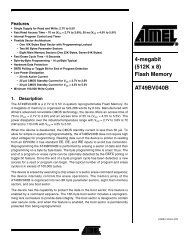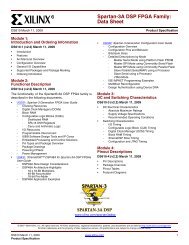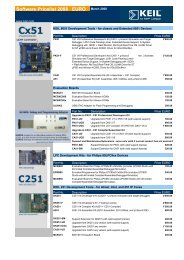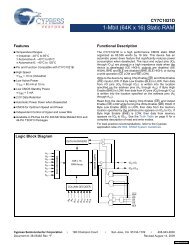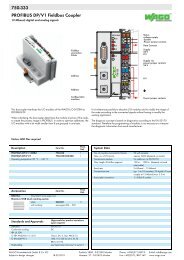PIC12F683 Data Sheet - Microchip
PIC12F683 Data Sheet - Microchip
PIC12F683 Data Sheet - Microchip
Create successful ePaper yourself
Turn your PDF publications into a flip-book with our unique Google optimized e-Paper software.
<strong>PIC12F683</strong><br />
12.3.1 POWER-ON RESET<br />
The on-chip POR circuit holds the chip in Reset until<br />
VDD has reached a high enough level for proper<br />
operation. To take advantage of the POR, simply<br />
connect the MCLR pin through a resistor to VDD. This<br />
will eliminate external RC components usually needed<br />
to create Power-on Reset. A maximum rise time for<br />
VDD is required. See Section 15.0 “Electrical<br />
Specifications” for details. If the BOR is enabled, the<br />
maximum rise time specification does not apply. The<br />
BOR circuitry will keep the device in Reset until VDD<br />
reaches VBOD (see Section 12.3.4 “Brown-Out Reset<br />
(BOR)”).<br />
Note:<br />
When the device starts normal operation (exits the<br />
Reset condition), device operating parameters (i.e.,<br />
voltage, frequency, temperature, etc.) must be met to<br />
ensure operation. If these conditions are not met, the<br />
device must be held in Reset until the operating<br />
conditions are met.<br />
For additional information, refer to the Application Note<br />
AN607, “Power-up Trouble Shooting” (DS00607).<br />
12.3.2 MCLR<br />
The POR circuit does not produce an<br />
internal Reset when VDD declines. To<br />
re-enable the POR, VDD must reach Vss<br />
for a minimum of 100 μs.<br />
<strong>PIC12F683</strong> has a noise filter in the MCLR Reset path.<br />
The filter will detect and ignore small pulses.<br />
It should be noted that a WDT Reset does not drive<br />
MCLR pin low.<br />
Voltages applied to the MCLR pin that exceed its<br />
specification can result in both MCLR Resets and<br />
excessive current beyond the device specification<br />
during the ESD event. For this reason, <strong>Microchip</strong><br />
recommends that the MCLR pin no longer be tied<br />
directly to VDD. The use of an RC network, as shown in<br />
Figure 12-2, is suggested.<br />
An internal MCLR option is enabled by clearing the<br />
MCLRE bit in the Configuration Word register. When<br />
MCLRE = 0, the Reset signal to the chip is generated<br />
internally. When the MCLRE = 1, the GP3/MCLR pin<br />
becomes an external Reset input. In this mode, the<br />
GP3/MCLR pin has a weak pull-up to VDD.<br />
FIGURE 12-2:<br />
SW1<br />
(optional)<br />
RECOMMENDED MCLR<br />
CIRCUIT<br />
12.3.3 POWER-UP TIMER (PWRT)<br />
The Power-up Timer provides a fixed 64 ms (nominal)<br />
time-out on power-up only, from POR or Brown-out<br />
Reset. The Power-up Timer operates from the 31 kHz<br />
LFINTOSC oscillator. For more information, see<br />
Section 3.5 “Internal Clock Modes”. The chip is kept<br />
in Reset as long as PWRT is active. The PWRT delay<br />
allows the VDD to rise to an acceptable level. A<br />
Configuration bit, PWRTE, can disable (if set) or enable<br />
(if cleared or programmed) the Power-up Timer. The<br />
Power-up Timer should be enabled when Brown-out<br />
Reset is enabled, although it is not required.<br />
The Power-up Timer delay will vary from chip-to-chip<br />
due to:<br />
• VDD variation<br />
• Temperature variation<br />
• Process variation<br />
See DC parameters for details (Section 15.0<br />
“Electrical Specifications”).<br />
Note:<br />
VDD<br />
R1<br />
1kΩ (or greater)<br />
R2<br />
100 Ω<br />
(needed with capacitor)<br />
C1<br />
0.1 μF<br />
(optional, not critical)<br />
MCLR<br />
PIC ®<br />
MCU<br />
Voltage spikes below VSS at the MCLR<br />
pin, inducing currents greater than 80 mA,<br />
may cause latch-up. Thus, a series resistor<br />
of 50-100 Ω should be used when<br />
applying a “low” level to the MCLR pin,<br />
rather than pulling this pin directly to VSS.<br />
DS41211D-page 86<br />
© 2007 <strong>Microchip</strong> Technology Inc.



